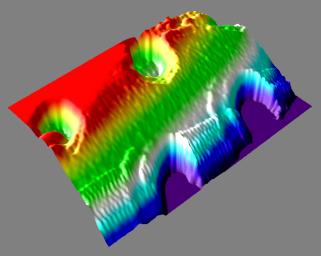
|
3-D View of Mars Particle
- Click the image above for a larger view
- Full-Res JPEG (605 x 482) (28.1 kB)
- Full-Res TIFF (605 x 482) (876.0 kB)
Caption:
This is a 3D representation of the pits seen in the first Atomic Force Microscope, or AFM, images sent back from NASA's Phoenix Mars Lander. Red represents the highest point and purple represents the lowest point.
The particle in the upper left corner —shown at the highest magnification ever seen from another world —is a rounded particle about one micrometer, or one millionth of a meter, across. It is a particle of the dust that cloaks Mars. Such dust particles color the Martian sky pink, feed storms that regularly envelop the planet and produce Mars' distinctive red soil.
The particle was part of a sample informally called "Sorceress" delivered to the AFM on the 38th Martian day, or sol, of the mission (July 2, 2008). The AFM is part of Phoenix's microscopic station called MECA, or the Microscopy, Electrochemistry, and Conductivity Analyzer.
Background Info:
The AFM was developed by a Swiss-led consortium, with Imperial College London producing the silicon substrate that holds sampled particles.
The Phoenix Mission is led by the University of Arizona, Tucson, on behalf of NASA. Project management of the mission is by NASA's Jet Propulsion Laboratory, Pasadena, Calif. Spacecraft development is by Lockheed Martin Space Systems, Denver.
Photojournal Note: As planned, the Phoenix lander, which landed May 25, 2008 23:53 UTC, ended communications in November 2008, about six months after landing, when its solar panels ceased operating in the dark Martian winter.
Cataloging Keywords:
| Name | Value | Additional Values |
|---|---|---|
| Target | Mars | |
| System | ||
| Target Type | Planet | |
| Mission | Phoenix | |
| Instrument Host | Phoenix Lander | Phoenix Mars Lander |
| Host Type | Lander | |
| Instrument | Microscopy, Electrochemistry, and Conductivity Analyzer (MECA) | |
| Detector | ||
| Extra Keywords | Atmosphere, Color, Dust, Storm | |
| Acquisition Date | ||
| Release Date | 2008-08-14 | |
| Date in Caption | 2008-07-02 | |
| Image Credit | NASA/JPL-Caltech/University of Arizona/University of Neuchatel/Imperial College London | |
| Source | photojournal.jpl.nasa.gov/catalog/PIA11039 | |
| Identifier | PIA11039 | |
